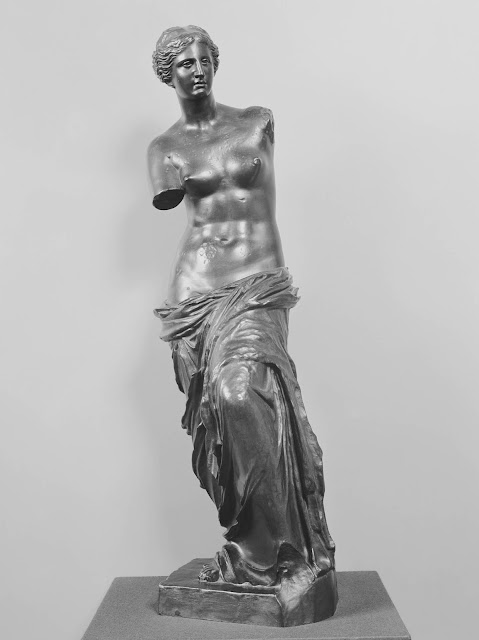 |
| Cupid and Psyche Roman marble copy of a late Hellenistic work Capitoline Museum |
The antique marble figures of Cupid and Psyche entered the Capitoline Museum in 1750, shortly after they were excavated and restored. Two other versions of the group already were known in Rome, but Haskell and Penny report that the Capitoline version quickly became the favorite. "It was the sentiment that most appealed to both travelers and scholars – 'the first burst of youthful loveliness' ; the 'innocent fondness' ; the 'virginal' and ingenuous gesture of the Psyche. But there were also many learned discussions of the philosophical allegory of the soul which the group might embody, and the execution was not always admired – Saint-Victor thought it was but a poor reflection of some earlier and superior work ..."
 |
| Marchino di Campertogno Cupid and Psyche ca. 1820-25 copy - ivory miniature statuette Victoria & Albert Museum |
 |
| Sèvres Manufactory Cupid and Psyche ca. 1770 porcelain Victoria & Albert Museum |
 |
| Auguste Desnoyers after Jean Auguste Dominique Ingres Cupid and Psyche 1803 engraving British Museum |
 |
| Anonymous photographer Cupid and Psyche ca. 1880-1904 photograph of a cast Rijksmuseum |
The vast marble carving known as the Farnese Bull (below) was discovered in the ruins of the Baths of Caracalla in 1545. By 1546 it was owned by the Farnese. "By 1550 or not long after, it had (on the advice of Michelangelo) been partially restored and placed in the second courtyard of the palace." After several moves, the Farnese Bull came to a stable home in the 19th century at the national museum in Naples. Another name sometimes used for this group was The Fable of Dirce.
 |
| Farnese Bull Roman marble copy after an earlier Hellenistic group National Archaeological Museum, Naples |
 |
| Underwood and Underwood, Publishers Farnese Bull ca. 1900 stereograph Getty Museum, Los Angeles |
 |
| François Perrier Farnese Bull 1638 etching Rijksmuseum |
 |
| Domenico de Rossi Farnese Bull ca. 1704 engraving Philadelphia Museum of Art |
 |
| Antoni Zürcher Farnese Bull late 18th-early 19th century engraving Rijksmuseum |
 |
| Peter Paul Rubens Farnese Bull early 17th century drawing British Museum |
"At first the group was praised enthusiastically by even the most sophisticated connoisseurs: thus Federico Zuccaro described this 'marvelous mountain of marble' as being, with the Laocoön, 'the most remarkable and marvelous work of the chisel of the ancients, showing what the art of sculpture can achieve at its most excellent'. This opinion continued to be held by many travelers and guides, but doubts about its quality were expressed with increasing frequency as the century advanced, though there was never any dispute that it was one of the most famous pieces of sculpture in the world – not least because it was one of the largest. ... Winckelmann did, however, emphasize how very extensive had been the restoration, ignorance of which, he suggested, had been responsible for so many absurd ideas about the work. There had long been anxieties on this score – anxieties which had clearly prompted Maffei's claim (also jeered at by Winckelmann) that only repairs of existing fragments had proved necessary and that nothing new had been added; the controversy continued about the degree of restoration, the authenticity and the quality of the Bull. With only a few exceptions – as late as 1802 a traveler called it 'the very finest group of ancient art, and superior even to the Laocoön' – opinion hardened against it, despite the most vigorous efforts of Neapolitan museum officials to sustain its declining reputation, and this decline continued throughout the nineteenth century."
 |
| Prévost Zachée Venus de Milo 1822 engraving Philadelphia Museum of Art |
The Venus de Milo was discovered quite late, in 1820. Even that late, it would certainly have been restored if officials at the Louvre had been able to agree about what position the arms should take. "The statue remains one of the most famous in the world, 'on sale in white plastic in the gift shops of Athens and everywhere else', but the author of a recent study of Aphrodite suspects that most of his readers are 'unmoved' by the 'rather chilly giantess in the Louvre'. Moreover, its reputation, 'which, started by propaganda, has become perpetuated by habit', perplexes the scholars who since the late nineteenth century have tended to place it in the second century BC and believe it to represent a revival of pre-Hellenistic ideals."
 |
| Anonymous sculptor Venus de Milo 1847 copy - bronze statuette Royal Collection, Great Britain |
 |
| Medows Firm Venus de Milo ca. 1850-73 copy - bronze statuette Royal Collection, Great Britain |
 |
| Jan de Bisschop Statue group of the Empress Faustina with Gladiator as Paramour 17th century wash drawing Victoria & Albert Museum |
In Taste and the Antique Frances Haskell and Nicolas Penny bring forward the example of an antique sculpture group famous during the Renaissance and now fallen into total obscurity. As illustrated immediately above by Jan de Bisschop, this pair of statues was thought to depict a scandalous episode from Imperial history when the Empress Faustina conceived an irresistible passion for a gladiator. Haskell and Panny would wish to go back and ask the Renaissance connoisseurs how they can possibly have believed the statues really represented this empress in the act of fondling her gladiator? The Roman historical record reports that powerful people shortly arranged for the gladiator to be murdered and removed from the scene in an effort to contain the scandal. Would this have been the the moment when a statue was needed? Who would have commissioned such an object, and where would it have stood? "Topical narrative of this type was never found in contemporary sculpture, and it is therefore very surprising that it should have been supposed common in antiquity."